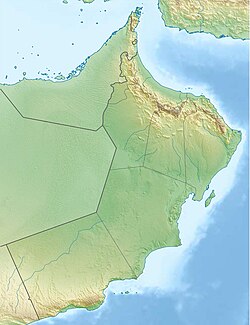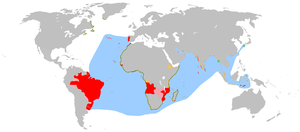Qalhat
Qalhāt
| |
|---|---|
 | |
 | |
| Coordinates: 22°41′58″N 59°22′10″E / 22.69944°N 59.36944°E | |
| Country | Oman |
| Governorate | Ash Sharqiyah South Governorate |
| Wilayat | Wilayat of Sur |
| Population (2010) | |
• Total | 1,123 |
| UNESCO World Heritage Site | |
|---|---|
 Bibi Maryam mausoleum | |
| Location | Sur Province, Ash Sharqiyah South Governorate, Oman |
| Criteria | Cultural: (ii), (iii) |
| Reference | 1537 |
| Inscription | 2018 (42nd Session) |
| Area | 75.82 ha |
| Buffer zone | 170.09 ha |
| Coordinates | 22°42′N 59°22′E / 22.700°N 59.367°E |
Qalhāt (Template:Lang-ar) is a village in Oman, over 20 km north of Sur. The residential area is to the northwest of Wādī Ḥilm (Template:Lang-ar), and the ruins of the ancient city are located to the southeast. The ancient city is referred to as Calatu by Marco Polo and as Calha in the map of Abraham Ortelius.
Site description
A rich Arab Omani merchant from the Madurai Sultanate, named Sa'idi Abu Ali (Paehali) 孛哈里 (or 布哈爾 Buhaer), was associated closely with the Madurai royal family. His father, also named Abu Ali was an Omani Arab from Qalhat (哈剌哈底) who moved to Madurai in South India where his son Sa'idi Abu Ali was born. After falling out with them, Sa'idi Abu Ali moved from Madurai to Yuan dynasty China and received a Korean woman as his wife and a job from the Mongol Emperor, the woman was formerly 桑哥 Sangha's wife and her father was 蔡仁揆 채송년 Chae In'gyu during the reign of 忠烈 Chungnyeol of Goryeo, recorded in the Dongguk Tonggam, Goryeosa and 留夢炎 Liu Mengyan's 中俺集 Zhong'anji.[1] 桑哥 Sangha was a Tibetan.
Marco Polo visited Qalhat in the 13th century, referring to it as Calatu. Ibn Battuta visited the city in the 14th century,[2] noting that it had "fine bazaars and one of the most beautiful mosques." He further noted the mosque was built by Bibi Maryam and included walls of qashani. Bibi Maryam continued to rule Qalhat and Hurmuz after the death of her husband Ayaz in 1311 or 1312.[3] Zheng He visited the city in the 15th century, and his crew called it 加剌哈 (Taihu Wu: ka-la-ha; Hokkien: ka-lat-ha; Cantonese: gaa-laat-haa).[4]
Qalhat served as an important stop in the wider Indian Ocean trade network, and was also the second city of the Kingdom of Ormus. By 1507 when it was captured by Afonso de Albuquerque on behalf of the Portuguese Empire, the city was already in decline as trade shifted to Muscat.[2] Covering more than 60 acres (240,000 m2), Qalhat was surrounded by fortified walls that contained houses and shops. Very little remains of the ancient city, save for the now dome-less mausoleum of Bibi Maryam. Artifacts from as far away as Persia and China were found on-site.[2]
Recently, a research conducted by geoarchaeologists of the University of Bonn conclude that earthquake activity along the most prominent structural element, the Qalhat Fault, is a plausible reason for the decline of the medieval city.[5]
World Heritage Site
This site was added to the UNESCO World Heritage Tentative List on July 4, 1988 in the Cultural category.[2] The ancient city became a World Heritage Site in 2018.[6]
Qalhat LNG Terminal
The Oman LNG LLC S.A.O.C. owned Qalhat LNG Terminal is situated at the Port of Qalhat.[7]
References
- ^ Angela Schottenhammer (2008). The East Asian Mediterranean: Maritime Crossroads of Culture, Commerce and Human Migration. Otto Harrassowitz Verlag. p. 138. ISBN 978-3-447-05809-4.
- ^ a b c d "The Ancient City of Galhat - UNESCO World Heritage Centre". UNESCO World Heritage Centre. Archived from the original on 1 February 2012. Retrieved 2 August 2018.
- ^ Battutah, Ibn (2002). The Travels of Ibn Battutah. London: Picador. pp. 96–98, 308. ISBN 9780330418799.
- ^ 向, 達 (1961). 鄭和航海圖. 北京: 中華書局.
- ^ Ermertz, Alina Marie; Kázmér, Miklos; Adolphs, Silja Kerstin; Falkenroth, Michaela; Hoffmann, Gösta (2019-09-27). "Geoarchaeological Evidence for the Decline of the Medieval City of Qalhat, Oman". Open Quaternary. 5 (1): 8. doi:10.5334/oq.56. hdl:10831/67449. ISSN 2055-298X.
- ^ "Ancient City of Qalhat". UNESCO.
- ^ Gas Media Releases Archived February 26, 2012, at the Wayback Machine


